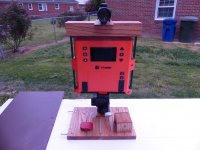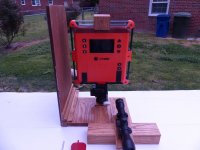Eval LabRadar
Yes, the labRadar has some problems. They being: 1) error – “Acquisition error: could not track the
projectile” 2) Vo is Way Off i.e. 4000+ ft/Sec, or way Low and 3) Vo appears correct, BUT is slightly low, or High, i.e. say all the shot except one are within ± 10 ft/Sec with the on being ±50 ft/sec. This one could be correct, but could also be INCORRECT. In (2) and (3) It will result in incorrect SD, average, and Min/Max.
I also noted when looking at individual track data – On a few of the points the bullet would INCREASE in velocity. Example: 26.91 yds V = 2657 ft/sec and at 27.8 yds V= 2663 ft/sec Picked up 6 ft/sec, Must have been ONE heck of a tail-wind gust – LOL. No explanation!
Case 1. Most likely cause is alignment or false triggering (at range with multiple shooters). False triggering can normally be reduced by reducing the sensitivity. Alignment – Good alignment with the target can be a pain using the “Notch”. Most common method is using a “Soda Straw” I find that a 3->4 dollar 6 inch x 3/16 inch metal tube (From Lowes) works better. Throw in some epoxy and wood for 10 bucks and you can mount it for more consistency in aligning the LabRadar. Another approach is using a scope. If you have a “cheap” scope on-hand for about 10-> 15 dollars you can mount it.
Case 2 & 3. First off, While the manual says that in triggered mode Vo is measured, I believe it is Calculated. If you look at individual track data you will see VO and the next reading will be 6 -> 7 milliseconds (approx. 5->6 yard) latter followed by measurements in interval of 1 milliSecs. You cannot measure what you cannot see and the bullet does not enter the radar beam until it is 5+ yards in-front of the barrel (6 in side separation from side of unit.
In the case where the reported VO definitely incorrect look at the farther out data, you will see that it falls back, and is in-line with the other shots. Simply extrapolate and change the Vo and recalculate SD, average (See Case 3)
In case 3 the reported Vo is reasonable, but higher than the average of all the other shots. Example:
As you can see Shot #2 Vo is much higher than 3 and 4, BUT is very close to 3 and 4 at 10 and 25 yards. I would say that shot #2 Vo should be approx. 2745. If you change Shot #2 Vo to 2745, SD would be 10.9 – IN-line with calculated SD at 10 & 25 Yards
Case (1). My method of alignment:
Yes, the labRadar has some problems. They being: 1) error – “Acquisition error: could not track the
projectile” 2) Vo is Way Off i.e. 4000+ ft/Sec, or way Low and 3) Vo appears correct, BUT is slightly low, or High, i.e. say all the shot except one are within ± 10 ft/Sec with the on being ±50 ft/sec. This one could be correct, but could also be INCORRECT. In (2) and (3) It will result in incorrect SD, average, and Min/Max.
I also noted when looking at individual track data – On a few of the points the bullet would INCREASE in velocity. Example: 26.91 yds V = 2657 ft/sec and at 27.8 yds V= 2663 ft/sec Picked up 6 ft/sec, Must have been ONE heck of a tail-wind gust – LOL. No explanation!
Case 1. Most likely cause is alignment or false triggering (at range with multiple shooters). False triggering can normally be reduced by reducing the sensitivity. Alignment – Good alignment with the target can be a pain using the “Notch”. Most common method is using a “Soda Straw” I find that a 3->4 dollar 6 inch x 3/16 inch metal tube (From Lowes) works better. Throw in some epoxy and wood for 10 bucks and you can mount it for more consistency in aligning the LabRadar. Another approach is using a scope. If you have a “cheap” scope on-hand for about 10-> 15 dollars you can mount it.
Case 2 & 3. First off, While the manual says that in triggered mode Vo is measured, I believe it is Calculated. If you look at individual track data you will see VO and the next reading will be 6 -> 7 milliseconds (approx. 5->6 yard) latter followed by measurements in interval of 1 milliSecs. You cannot measure what you cannot see and the bullet does not enter the radar beam until it is 5+ yards in-front of the barrel (6 in side separation from side of unit.
In the case where the reported VO definitely incorrect look at the farther out data, you will see that it falls back, and is in-line with the other shots. Simply extrapolate and change the Vo and recalculate SD, average (See Case 3)
In case 3 the reported Vo is reasonable, but higher than the average of all the other shots. Example:
| Shot ID | V0 | V10 | V25 |
1 | 2722 | 2697 | 2663 |
2 | 2772 | 2723 | 2686 |
3 | 2745 | 2721 | 2685 |
4 | 2735 | 2713 | 2680 |
| SD | 21.2 | 11.8 | 10.7 |
As you can see Shot #2 Vo is much higher than 3 and 4, BUT is very close to 3 and 4 at 10 and 25 yards. I would say that shot #2 Vo should be approx. 2745. If you change Shot #2 Vo to 2745, SD would be 10.9 – IN-line with calculated SD at 10 & 25 Yards
Case (1). My method of alignment:



